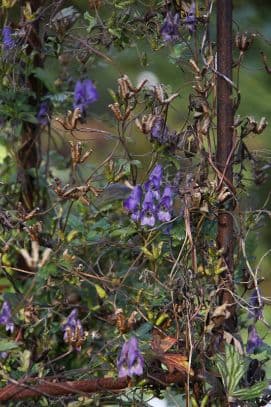Clematis Fragrant Oberon Clematis Fragrant Oberon = 'Hutbron' (PBR) (Fo)
![clematis [Fragrant Oberon]](/_next/image?url=https%3A%2F%2Fplants-admin.emdemapps.com%2Fimages%2Fplants%2F%2Fimages%2F604b5e3c8760d.png&w=3840&q=75)
ABOUT
Clematis Fragrant Oberon, also commonly known as simply Clematis, is a climber recognized for its desirable traits and ornamental features. The Clematis boasts creamy-white flowers that can be identified by their unique composition of numerous tepals—each one having a rounded, petal-like shape. These tepals encircle a prominent center filled with a tuft of creamy, yellow stamens, which provide a lovely contrast to the whiteness of the petals and contribute to the plant's overall charm. The Clematis Fragrant Oberon's flowers emit a delightful fragrance, which is relatively unusual among clematis varieties. This adds an extra layer of sensory appeal to the plant, making it a sought-after choice for gardens where scent is an important aspect of the design. In addition to its flowers, the plant features rich, green leaves consisting of multiple leaflets. These leaflets are usually arranged in pairs along the climbing stems. The foliage provides a lush backdrop for the flowers and remains an attractive feature even when the plant is not in bloom, giving the Clematis year-round visual interest. The appearance of Clematis Fragrant Oberon can vary throughout the seasons, starting from its early growth in the spring, through its full bloom in the appropriate months, and into the senescence of flowers as the petals will eventually give way. However, its climbing habit and green foliage ensure that it remains a constant presence in the garden, continuously providing structure and texture to the landscape.
About this plant
 Names
NamesSynonyms
Fragrant Oberon Clematis.
Common names
Clematis Fragrant Oberon = 'Hutbron' (PBR) (Fo)
 Characteristics
CharacteristicsLife cycle
Perennials
Foliage type
Deciduous
Color of leaves
Green
Flower color
White
Height
6-8 feet (1.8-2.4 meters)
Spread
3 feet (0.9 meters)
Plant type
Climber
Hardiness zones
4
Native area
Asia
Benefits
 General Benefits
General Benefits- Attractive Blooms: The plant boasts a prolific display of small, white, fragrant flowers that are visually appealing.
- Compact Growth: Its compact growth habit makes it suitable for smaller gardens or limited spaces.
- Climbing Ability: Being a climber, it can be trained on trellises, fences, or walls, adding vertical interest to gardens.
- Seasonal Interest: It provides seasonal interest in spring and summer when in bloom, enhancing the aesthetic appeal of the garden.
- Easy Care: Clematis Fragrant Oberon is relatively easy to care for and requires minimal maintenance once established.
- Pest Resistance: It has good resistance to common clematis pests, reducing the need for chemical treatments.
- Versatility: The plant is versatile and can be used in mixed borders, container gardening, or as a standalone feature.
- Long Bloom Period: The flowering season is long, providing extended enjoyment.
- Hardiness: It is a hardy plant that can withstand cold temperatures once mature, making it suitable for various climates.
- Attracts Pollinators: The sweet fragrance and accessible flowers attract bees and other pollinators, supporting biodiversity.
 Medical Properties
Medical PropertiesThis plant is not used for medical purposes.
 Air-purifying Qualities
Air-purifying QualitiesThis plant is not specifically known for air purifying qualities.
 Other Uses
Other Uses- Clematis Fragrant Oberon can be used as a natural dye source, with different parts of the plant yielding a variety of subtle colors for textiles and crafts.
- When dried, the vines of clematis can be woven into baskets, wreaths, or other decorative items due to their flexibility and durability.
- Draped over pergolas or arbors, clematis provides a natural, living canopy that offers shade and visual interest in garden spaces.
- The plant can be used in art installations or as living sculptures by training the vines over frames to create organic shapes and forms.
- The seed heads of clematis can be left on the plant to add winter interest to the garden, with their fluffy, silvery appearance.
- Clematis petals may be incorporated into homemade potpourri mixes, imparting a subtle fragrance and adding bits of color.
- As a tool for education, clematis can be grown in schools to teach students about plant growth, climbing mechanisms, and pollination.
- The plant can be used as a natural privacy screen when grown along fences or walls, providing seclusion with its dense foliage.
- Gardeners can use clematis as part of a companion planting strategy to add vertical interest among other shrubs and perennials.
- The planting of clematis can support wildlife, such as bees and butterflies, by providing nectar when other food sources are scarce.
Interesting Facts
 Feng Shui
Feng ShuiThe Clematis is not used in Feng Shui practice.
 Zodiac Sign Compitability
Zodiac Sign CompitabilityThe Clematis is not used in astrology practice.
 Plant Symbolism
Plant Symbolism- Mental Agility: Clematis is often associated with cleverness and intellectual pursuits due to its complex structure, perhaps suggesting the ability to navigate intricate thoughts.
- Creativity: The striking appearance and the profuse blooming nature of the Clematis symbolize creativity and the constant flow of new ideas.
- Aspiration: In the language of flowers, Clematis represents lofty aspirations and climbing to new heights, reflecting the plant’s natural climbing habit.
- Spiritual Exploration: Its growth toward the sky can symbolize the human aspiration for higher spirituality and enlightenment.
- Beauty in Diversity: With the many varieties and colors of Clematis, it comes to symbolize the beauty and unity found in diversity.
 Water
WaterClematis 'Fragrant Oberon' should be watered with a thorough soaking method, ensuring water reaches the roots deeply. It is best to water early in the morning to avoid evaporation loss. During the growing season, water the plant once a week with about 1 gallon per session. In hot, dry weather, increase the frequency to twice a week. Reduce watering in the dormant season to prevent waterlogging, which might cause root rot.
 Light
LightThe Clematis 'Fragrant Oberon' thrives best in full sun to partial shade. The ideal spot for planting is where it receives at least six hours of sun a day, but is shaded during the hottest part of the afternoon. Morning sun with protection from the intense late-day sun encourages the most blooming without stressing the plant.
 Temperature
TemperatureClematis 'Fragrant Oberon' can typically withstand a temperature range from around 25 degrees Fahrenheit to 95 degrees Fahrenheit. However, they prefer to be in a location where the temperature is between 55 and 75 degrees Fahrenheit for optimal growth. Adequate mulching can help roots stay cooler in summer and prevent freezing in winter.
 Pruning
PruningClematis 'Fragrant Oberon' should be pruned to maintain shape and promote healthy growth. Prune lightly after blooming to remove dead or weak stems, which helps prevent disease and encourages new growth. The best time to prune is late winter or early spring, before the onset of new growth.
 Cleaning
CleaningAs needed
 Soil
SoilFragrant Clematis Oberon prefers a well-draining soil mix with a pH between 6.0 and 7.0. A mix of one part garden soil, one part compost or well-rotted manure, and one part sharp sand or perlite will provide the required drainage and fertility. Mulching with organic material can also be beneficial to maintain moisture.
 Repotting
RepottingFragrant Clematis Oberon should typically be repotted every two to three years to refresh the soil and provide space for root growth. The best time for repotting is in the early spring before the growing season begins.
 Humidity & Misting
Humidity & MistingFragrant Clematis Oberon thrives in outdoor conditions where the humidity tends to be variable. Ideally, they prefer moderate humidity levels, but as garden plants, they adapt well to the humidity levels common to the outdoor climate where they're grown.
 Suitable locations
Suitable locationsIndoor
Give Fragrant Clematis Oberon bright light, cooler temps, limit growth.
Outdoor
Plant in sun to part-shade; train on a trellis or support.
Hardiness zone
4-9 USDA
 Life cycle
Life cycleClematis Fragrant Oberon, commonly known simply as Clematis, starts its life cycle as a seed, which germinates in spring when soil temperatures rise and moisture levels are adequate. After germination, the young seedling begins to develop a root system and foliage through the vegetative growth stage, focusing on gaining strength and size. As it matures, the Clematis enters the flowering stage, typically in late spring to early summer, producing fragrant flowers that attract pollinators and ultimately lead to seed formation. Once pollinated, the flowers develop into fruits, each carrying multiple seeds that, when mature, disperse to start a new life cycle. During the fall and winter months, this perennial plant may die back above ground but will persist through its root system, entering a period of dormancy. With the onset of the next growing season, the Clematis breaks dormancy, resuming growth from its established root base and starting the cycle anew.
 Propogation
PropogationPropogation time
Spring-Early Summer
The Clematis Fragrant Oberon is commonly propagated through softwood cuttings. This technique is usually performed during late spring or early summer when new growth is soft and flexible. To do this, a cutting of about 4 to 6 inches (10 to 15 centimeters) is taken from the vine, ensuring there are at least two sets of leaves. The bottom set of leaves is removed and the cut end is dipped in rooting hormone powder to encourage root development. The cutting is then placed in a pot filled with a mix of perlite and peat moss and kept uniformly moist but not waterlogged. The pot should be placed in a bright location without direct sunlight and covered with plastic to maintain humidity until roots develop, usually within a few weeks to a few months. Once rooted, the new clematis plant can then be hardened off and eventually planted into the garden.









